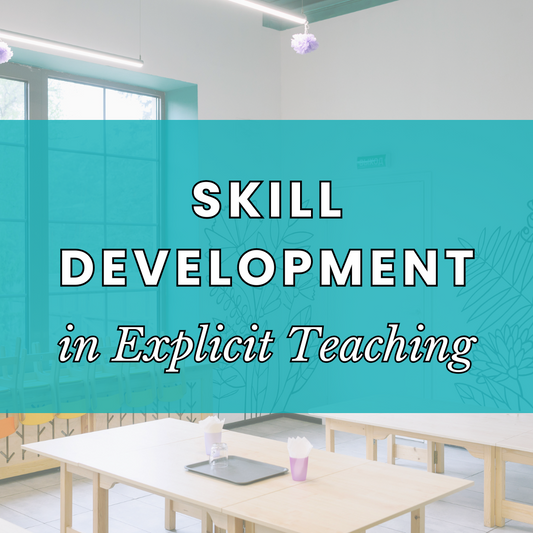
Explicit Teaching Instructional Routines
Share
When it comes to explicit teaching, instructional routines are the backbone of a successful lesson. In particular, these routines provide a predictable structure for students to engage in each part of the lesson, ensuring clarity and focus. By establishing these routines early, students can spend less time figuring out how to engage and more time on the what they’re learning.
Here’s how to design and implement effective instructional routines for explicit teaching, with practical strategies and tools to get you started.
What Are Instructional Routines for Explicit Teaching?
Instructional routines guide how students interact and engage in each part of the lesson. For instance:
- Will students write their responses in exercise books, or will they track responses with you as you model?
- Will they use mini whiteboards for quick check-ins?
Deciding on these routines in advance and teaching them explicitly ensures students know what’s expected. Once established, routines save valuable lesson time and enhance student focus.
1. Set Expectations Early
At the beginning of the year (or term), it’s crucial to teach expectations for every part of the lesson. This includes:
- Behavior during instruction (e.g., when to listen, when to respond).
- How to use tools like mini whiteboards or exercise books.
- What quality work looks like in each lesson phase.
Teaching these expectations doesn’t have to be time-consuming. Start with a few dedicated sessions and reinforce them regularly. To make this easier, my Daily Slides Pack includes template slides specifically designed to introduce expectations for instructional routines. These editable slides save you time while ensuring your routines are consistent and clear.
2. Mini Whiteboards: Quick, Effective Responses
One of the simplest ways to check for understanding without disrupting the flow of the lesson is by using mini whiteboards. They allow students to give one-word or quick responses that you can scan in real time. Here’s how to maximise their impact:
- Teach students how to use whiteboards. Start the year by modeling when and how to write responses (e.g., short, neat answers only when prompted).
- Practice routines for erasing and holding up answers. Ensure this process is smooth to maintain the pace of the lesson.
- Use targeted questions. For example, ask students to define a word, give an example, or solve a quick problem.
These small, quick interactions not only keep students engaged but also provide immediate insights into their understanding.
3. Concept Development: Beyond Definitions
After the daily review, you’ll transition into concept development—introducing new vocabulary or ideas central to the lesson. This is where students engage deeply with the material. Consider:
- Providing examples and non-examples of the concept to build clarity.
- Asking students to generate their own non-examples to solidify understanding.
- Deciding how students will interact with the vocabulary. Will they:
- Write definitions in their exercise books?
- Track with you on their whiteboards?
- Discuss examples with a partner?
Clear expectations for how students engage with concept development will keep them focused and on track.
4. Feedback in Real-Time
One of the biggest benefits of explicit teaching is the opportunity to provide real-time feedback. By scanning responses on mini whiteboards or exercise books, you can:
- Address misconceptions before they solidify.
- Offer specific praise for correct responses.
- Adjust your teaching to meet students’ needs.
For example, after posing a question during the We Do phase, quickly scan the room. If a majority of students respond correctly, you can move forward. If not, pause to reteach or clarify.
5. Resources That Support Routines
Explicit teaching is all about structure, and having ready-to-use resources for each part of the lesson can save you hours of planning. My Daily Slides Pack includes:
- Slides for setting expectations in each part of the lesson.
- Check for understanding prompts (tailored for mini whiteboards).
- Templates for daily routines like morning meetings, emotions check-ins, and group rotations.
These resources not only streamline your planning but also ensure consistency in your routines, helping students thrive in a structured environment.
Establishing effective instructional routines is essential for creating a classroom environment where students know what to expect and how to engage. To help you streamline your teaching, I’ve developed resources that support each part of the explicit teaching lesson structure:
- Traffic Light Posters: A clear visual guide for your students to transition smoothly through the "I Do, We Do, You Do" phases. These posters make expectations for each part of the lesson visible and help students stay on track.
- Free Resource Bank: Access a collection of ready-to-use templates, including check-for-understanding slides, visible learning posters, and more to simplify your lesson preparation.
Visit my Free Resource Bank to explore practical tools designed to support your instructional routines and keep your students engaged throughout the lesson.
6. Why Instructional Routines Matter
Instructional routines aren’t just about saving time—they’re about creating an environment where students know exactly what to expect. When routines are consistent:
- Students feel more confident and engaged.
- Lessons run smoothly, with fewer interruptions.
- Teachers can focus on teaching, not managing behavior or logistics.
By investing time in teaching and reinforcing these routines, you’ll set the foundation for a year of successful, impactful lessons.
Get Started Today
If you want to simplify your explicit teaching routines and enhance student engagement, then Follow me on Instagram for quick tips and teaching hacks. Plus, explore my free Explicit Teaching Resource Bank for tools to help you implement these strategies with ease. Let’s make teaching simpler, more effective, and stress-free!





